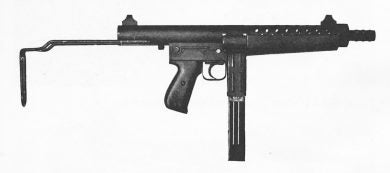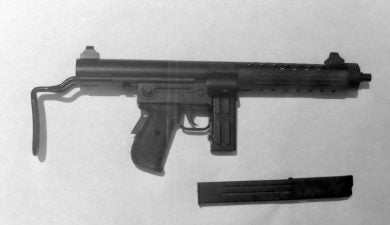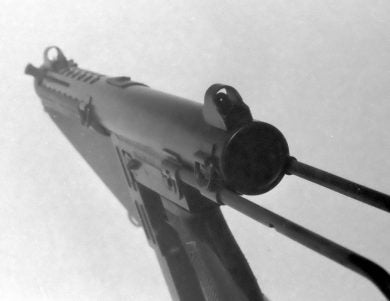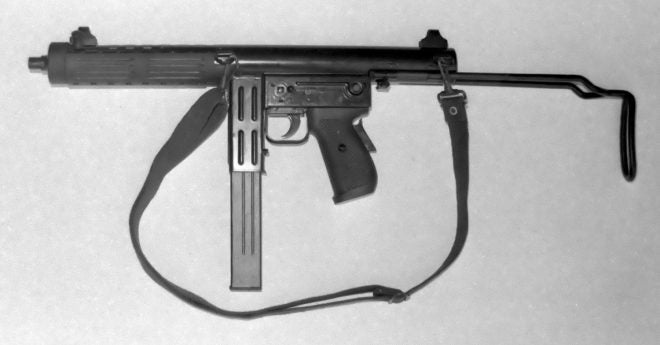During TFB’s recent series of posts on Brazilian gun designer Nelmo Suzano (such as in https://www.thefirearmblog.com/blog/2017/02/02/socimarte-bergom-phase-guns-nelmo-suzano/) , it was often mentioned that he was closely associated with a friend called Luiz Gonçalves from the Bérgom S/A company. In addition to the several submachine guns described in the series, an additional model was intentionally left unmentioned, since it was primarily the brainchild of Nelmo’s pal. That was the BSM/9M3.

The original Bérgom BSM/9M3 submachine gun by Luiz Gonçalves.
Chambered to the 9x19mm round, this private venture gun was ready in prototype form in the late 1970s and began being commercially promoted, though in a very limited scale, in the early 1980s. It was a pretty conventional, blowback-operated selective-fire weapon which used a short bolt with no overhang which ran on two guide rods with separate, small-diameter return springs. The cylindrical body was the largest item from the gun, and field stripping, requiring no tools, consisted of removing the various groups from the body, leaving it largely intact. The entire trigger group assembly was removed by taking out two pins, the barrel was held in by a screw collar at the fore end of the body, and the bolt/ springs were kept in place by a cap at the rear end.
A light wire-type stock (pretty much like the M3/M3A1 Grease Gun’s) retracted alongside the body, while the forward handguard was a fixed plastic item under the barrel casing, the pistol grip being made of the same material. The magazine housing was just ahead of the trigger guard, 20- and 32-round magazines being provided. The ejection port, to the right, was covered by a spring-loaded cover which automatically opened when the action was cocked. One noticeable characteristic of the BSM/9M3 was the very long (397mm) radius of the hood-protected sights, a fixed 100m aperture rear unit and a front post.
With a 228mm barrel (muzzle velocity: 400 m/s), the gun’s overall length was 698mm, reducing to 489mm with the stock retracted. Unloaded weight was a bit over 3kg, while cyclic rate of fire was about 600 rounds per minute.

The somewhat redesigned SMG re-appeared in 1982-83 as the Mtr M 9 M1-CEV.
Soon afterwards, a long-established explosives manufacturer, Companhia de Explosivos Valparaíba with facilities in Lorena, São Paulo State, decided to enter the armament field, too. A submachine gun was chosen as the simpler first step, and instead of going ahead with the development of a new design – which would consume more time and funds than it was willing to spend – CEV looked around for existing, available designs. Thus, negotiations with the Bérgom people result in obtaining plans of the BSM/9M3.
Redesignated Mtr M (Metralhadora de Mão, Hand-held Machine Gun) 9 (caliber) M1 (First Model) – CEV (the company’s initials), the weapon was modified to some extend by in-house technicians, had a small toolroom-made batch completed, received Brazilian Army product certification, and began being commercially promoted, while tooling for possible large-scale manufacture was under way at the Lorena factory.

Right side view of the CEV submachine gun, wire stock retracted, 30-round magazine removed.
The main modifications added to the “new” gun were a slightly longer (256mm) barrel, reduction of the staggered-row single-position feed magazine capacity to 30 rounds (20-round units also available), the use of a straight-line polymer handguard, and the addition of a safety lever on the rear of the pistol grip. General dimensions and weights did not change significantly, but somehow the cyclic rate of fire was reduced to the 500-rpm range.

This closer view of gun shows reinforcing pressed ribs on the magazine housing and positions of the fire selector above trigger (“S”, forward; “30”, bottom; and “1”, rearward, top). What appears to be a curved receiver is the result of the author having used a wide-angle lens to take the photo.
Having briefly handled and fired the Mtr M 9 M1-CEV back in February, 1983, I can recall it was a no-frills buzzgun which was simple to disassembly for basic maintenance, worked flawlessly (in my hands, at least), and was decently accurate at the expected ranges, mainly thanks to its comfortable cyclic rate of fire. Anyway, it was also one more design that never made it to the market, local or world!

Fully field-stripped for basic maintenance, the Mtr M 9 m1-CEV shows its short cylindrical bolt, dual guide rods with integral small-diameter return springs, and the grip assembly which housed the firing mechanism.

Angle of this picture allows a good view of gun’s protected sights and the position of the non-reciprocating cocking handle, well forward 45 degrees to the left of the perforated tubular receiver.

The 30-round box magazine being inserted in the gun. Although it was a single-position feed unit, which normally require higher bolt force to have rounds stripped, I didn’t have any malfunction of the CEV at the time of my firings in Lorena, in February 1983.

A generous sight radius coupled with a very moderate cyclic rate of fire made the Mtr M 9 M1-CEV an attractive, straightforward proposition.
 Your Privacy Choices
Your Privacy Choices
